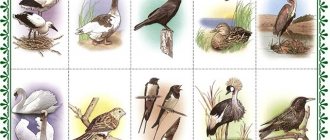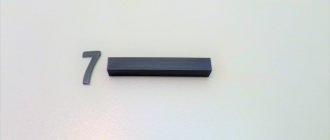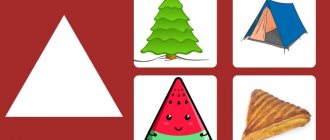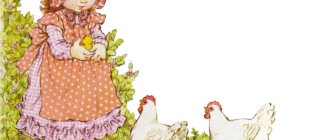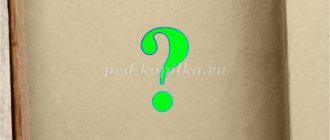Goal : Formation of elementary mathematical concepts in children of the older group using
Cuisenaire rods .
Tasks :
Educational:
1. Reinforce the concept that the stick (each color) has its own number.
2. Exercise your ability to work with diagrams using your imagination.
3. Teach children to make the number 6 from two smaller numbers;
4. Strengthen children’s understanding of size (length) and color.
6. Expand and consolidate children’s knowledge about fairy tales.
Educational:
1. Develop memory, logical thinking, imagination, attention, speech,
ability to reason and prove.
Educators:
1. Cultivate an interest in mathematics and the ability to work in a team.
Equipment:
Cuisenaire sticks for each child , diagram for building a car, cards with cribs for each child, presentation.
Treats for children. Methodical techniques:
Visual;
Verbal (reminders, instructions, questions);
Gaming (surprise moment);
Encouragement, differentiated analysis of the lesson.
The first stage of working with Cuisenaire sticks: play
Cuisenaire sticks are recommended for use with children from one year of age. The first stage is the gaming stage. Cuisenaire sticks replace construction sets and mosaics.
To begin with, a simple introduction will be enough: let the child pick them up and examine them. Such a simple task is useful in itself: it develops fine motor skills and visual perception. A little later, the actions can be supplemented with comments: this stick is red, it is long, and this stick is white, it is short. It will be clearer for your child if you try to convey these concepts through a fairy tale: for example, build a multi-colored fence for three little pigs. For example, Nif-nif will have a small white fence, Naf-naf will have a red fence that is 2 times larger and longer, and Nuf-Nuf will have the longest and tallest fence - brown.
There are certain schemes according to which you can create a whole plot picture.
The next step is to master comparisons and the concept of part and whole. For example, Cheburashka loves to eat candy. He can choose: either to enjoy one blue candy, but large, or a large number of white candies, but small. Which candies will Cheburashka choose? How many white candies fit into one big blue candy? This way, you introduce your child to the basics of counting.
Gradually, lesson after lesson, game after game, the baby will master the simplest counting within ten.
Other examples of tasks at the initial stage:
- Arrange the sticks by length and color.
- Ask your child to put the same number of sticks and the same color as yours.
- Lay out several sticks in a row, give a couple of seconds for the child to remember them. Ask him to turn away - and remove one stick from the row. The kid must guess which stick is missing.
- Mix all the Cuisenaire sticks. Ask your child to sort them according to color into piles labeled with color.
- Using a red stick, measure the length of surrounding objects: bed, table, book.
- Lay out the figure and ask the child to make the same one.
- Ask your child, with his eyes closed, to find two sticks of different lengths. Give a hint what color one stick is. Can he guess what color the other stick is?
- How much longer is one stick longer than the other?
- Ask your child to choose the shortest and longest sticks from the set.
What are Cuisenaire's rods?
The Cuisenaire technique is implemented in sticks, which are also called: counting sticks, numbers in color, colored sticks, colored rulers, Cuisenaire counting sticks.
Cuisenaire rods are 10 parallelipipids of different colors and sizes, made of wood or plastic. Their length ranges from 1 to 10 centimeters.
Cuisenaire sticks correspond to the designation of numbers: the longer the stick, the larger the number it represents. The shortest stick means a one, a stick twice as long means a two, and so on.
Sticks that are similar in color are grouped into families or classes. For example, a red stick represents 2, a brown stick represents 4, and a cherry stick represents 8: thus, all of the Cuisenaire sticks listed above can be classified as members of the family of numbers that are multiples of 2.
There are 5 families or classes in total:
You can make Cuisenaire sticks yourself: for this you will need colored cardboard and scissors. The smallest strip, responsible for the “unit,” measures 2 by 2 cm, all subsequent strips increase in length by 2 centimeters.
The tasks that can be performed with cardboard strips are quite limited - the flat version does not allow for the construction of three-dimensional figures. However, the cardboard version of Cuisenaire sticks is also popular and is suitable for getting acquainted with the technique.
Cuisenaire sticks can be stored in a separate bag or box, but it is best if it is a special box with compartments designed for each stick. In this case, upon completion of the lesson, the child will have to choose the right “house” for the multi-colored family and put all the sticks neatly.
Self-analysis of the teacher
Integration of educational areas: “Cognitive development”, “Speech development”, “Socio-communicative development”.
Goal: Consolidation of mathematical knowledge and skills, constructive thinking through the game - travel, using Cuisenaire sticks and Dienesh blocks.
Tasks:
1) Fix the composition of the number 8, ordinal counting and numbers within 10, the concepts of “previous” and “subsequent”;
Strengthen the ability to build according to a given pattern from Cuisenaire sticks (find the connection between number and color, number and color of the stick), teach analysis and synthesis;
Strengthen computing skills, the ability to select blocks according to given properties; teach children to perform arithmetic operations for addition and subtraction, practice denoting the result of addition and subtraction by number;
Teach children to measure the length of an object using three conventional standards, to develop knowledge about the independence of length from measurement;
Develop logical thinking: the ability to coordinate and decode information about the properties of objects, break a set into two compatible properties, perform logical operations “not”, “and”, “or”. ("Cognitive Development")
2) Activate children’s vocabulary: interactive, coherent speech, ability to answer questions: which one? which one?, use comparisons (long, short, shorter, even shorter). (“Speech development”)
3) Promote the development of skills of mutual verification and self-assessment. Foster a sense of mutual assistance and a desire to help. Encourage attempts to express your point of view (“Socio-communicative development”).
The lesson was held in a preparatory group. The lesson consisted of three interconnected stages, during which the children gradually performed various actions. The goals and objectives correspond to the target guidelines of the Federal State Educational Standard for Education. To achieve the goal, an educational environment was created, the goals and objectives correspond to age capabilities. There is a connection between goals and objectives and the theme of educational activities.
During the lesson, a person-oriented model of activity was used. Questions of a problem-search nature predominated. The following methods and techniques were used to activate children:
- practical - work with diagrams, Cuisenaire sticks, Dienesh blocks, the game “Draw the missing image in an empty square”, physical exercises, the game “Get in order”, problem solving.
— visual – diagrams of a bridge, a ship; map with symbols, multimedia.
- verbal - questions, conversation, reminder, explanation.
All the children freely turned to me for help when faced with difficulties in solving a particular issue. Throughout the lesson, problematic situations were created to solve the assigned problems.
At the beginning of the lesson, I used a surprise moment - a phone call from Africa asking for help in measuring the length of a boa constrictor. All elements of the lesson are logically united by a common theme.
One type of activity smoothly transitioned into another. To implement each task, I selected techniques that helped solve them. The techniques were based on playful learning situations in which I tried to encourage children to engage in active speech activity. The children were active, attentive, and felt comfortable.
I believe that the form of organization of the lesson I chose was quite effective and dynamic. I tried to be a partner, an assistant for the children, and to observe the norms of pedagogical ethics and tact. She tried to construct her statements competently and easily for children to understand, encouraged children to show initiative and independence, and encouraged children’s individual achievements.
The activities of all children were assessed positively, their personal dignity was not belittled.
This structure of the lesson is completely justified. I believe that the objectives set in the lesson were completed. The activity achieved its goal.
Author: Ermolaeva Marina Vladimirovna, teacher of the State Budgetary Educational Institution of the Samara Region, secondary school No. 2 railway. Art. Shentala municipal district Shentala, Samara region, structural unit of the kindergarten “Zvezdochka”, Russia.
The article is published in the author's edition
Cuisenaire rods and language learning
Cuisenaire rods are widely popular as teaching materials for teaching mathematics. But their role in language learning is also very great. Abroad, sticks are actively used in English lessons; they help highlight unstressed and stressed syllables and emphasize rhythms. This technology can be successfully applied in our native language, Russian.
This is how we show the stress and divide the syllables accordingly - a very popular technique for teaching reading, which you may have seen before in our alphabet books:
Cuisenaire rods provide a clear illustration for comparative adjectives.
Cuisenaire's technique: advantages
Cuisenaire's technique is universal; it does not conflict with any of the existing techniques, but, on the contrary, successfully complements them.
Cuisenaire sticks are simple and understandable to children: they get used to them at a very early age and already perceive them as playing material, and do not see them as boring memorization of numbers.
In addition to the obvious effectiveness of teaching the technique, Cuisenaire's rods also involve a number of border areas: they develop fine motor skills, visual and spatial perception, stimulate the imagination, and teach order.
The second stage of working with Cuisenaire rods: mathematical
The second stage of working with sticks is mathematical. Children literally learn to “feel” numbers, that is, learning takes place not through abstract concepts, which are still very vague for children, but through practice.
Cuisenaire sticks will help you master fractional numbers. For example, take a brown stick representing the number 4. How many red sticks fit into it and, accordingly, what part is the red stick from the brown one?
It's 2/4
How many green sticks fit into a brown stick and what part does the green stick make up of the whole? It's 3/4
It's 9/10
Cuisenaire rods are a simple “calling card” of the multiplication table. Let's start with a white stick representing the number one. If you take it in the singular, you get the number one. If you take ten white sticks, you get the number 10, which you need to check with the “right stick.”
Other examples of tasks at the second stage:
- Take several white sticks and move them close together in a row. Find an analogue in the set.
- You name the number and the child finds a stick of the corresponding color. At first, the numbers can be called in order, but then the task becomes more complicated, the numbers come apart.
- Take the shortest stick. What color is it? The white stick is a unit, the number “one”.
- For a colored stick, you need to match its analogue, shown on the card in the form of a number.
